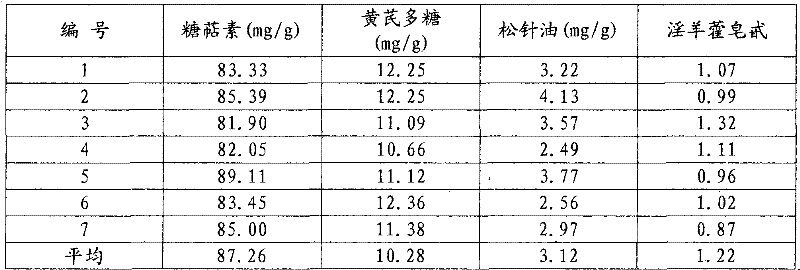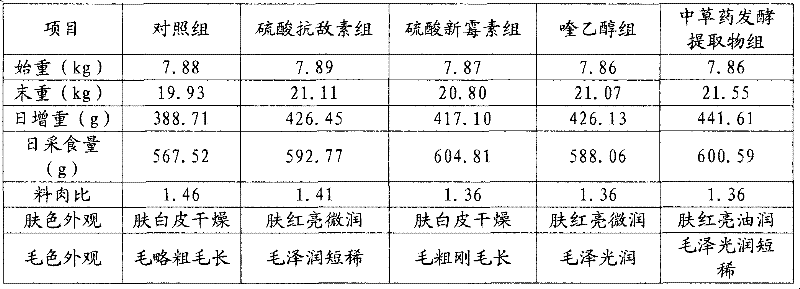Method for preparing antibiotic substituent for feed by probiotic asynchronous fermentation of Chinese herbal medicine
An asynchronous fermentation, Chinese herbal medicine technology, applied in the fields of microorganisms, feed, and food nutrition, can solve the problems such as the lack of separate drying of medicinal residues and medicinal liquids, the lack of scientific prescriptions, and the singleness
- Summary
- Abstract
- Description
- Claims
- Application Information
AI Technical Summary
Problems solved by technology
Method used
Image
Examples
Embodiment 1
[0023] Weigh 1000kg of camellia seed cake powder, 300kg of eucommia leaves, 300kg of astragalus, 250kg of hawthorn, 250kg of pine needle powder, 200kg of epimedium, and 200kg of licorice. 120 meshes (crossing a 0.15mm sieve) are made into compound Chinese herbal medicine for subsequent use.
[0024] Weigh 100kg of glucose, 24kg of yeast extract, K 2 HPO 4 15kg, NaCl 6kg, MgSO 4 0.9kg, mixed to make nutrient salt for later use.
[0025] After activating the strains of Aspergillus niger, Enterococcus lactis and Lactobacillus plantarum twice with slant and MRS liquid medium, they were inoculated into 250mL Erlenmeyer flasks with a liquid volume of 100mL in each bottle. 7 The CFU / mL concentration was added to the 5L liquid seed fermenter, and then press 1.5×10 7 The CFU / mL concentration was expanded into a 50L liquid seed fermenter, cultured and fermented at 39°C for 24 hours, and the Aspergillus niger strain liquid and the mixed strain liquid of Enterococcus lactis and Lactob...
Embodiment 2
[0031] Weigh 500kg of camellia seed cake powder, 150kg of eucommia leaves, 150kg of astragalus, 125kg of hawthorn, 125kg of pine needle powder, 100kg of epimedium, and 100kg of licorice. 120 meshes (crossing a 0.15mm sieve) are made into compound Chinese herbal medicine for subsequent use.
[0032] Weigh 50kg of glucose, 12kg of yeast extract, K 2 HPO 4 7.5kg, NaCl 3kg, MgSO 4 0.45kg, mixed to make nutrient salt for later use.
[0033] After activating the strains of Aspergillus niger, Enterococcus lactis and Lactobacillus plantarum twice with slant and MRS liquid medium, they were inoculated into 250mL Erlenmeyer flasks with a liquid volume of 100mL in each bottle. 7 The CFU / mL concentration was added to the 5L liquid seed fermenter, and then press 1.5×10 7 The CFU / mL concentration was expanded into a 50L liquid seed fermenter, cultured and fermented at 39°C for 24 hours, and the Aspergillus niger strain liquid and the mixed strain liquid of Enterococcus lactis and Lactob...
Embodiment 3
[0039] Weigh 5000kg of camellia seed cake powder, 1500kg of eucommia leaves, 1500kg of astragalus, 1250kg of hawthorn, 1250kg of pine needle powder, 1000kg of epimedium, and 1000kg of licorice. 120 meshes (crossing a 0.15mm sieve) are made into compound Chinese herbal medicine for subsequent use.
[0040] Weigh 200kg of glucose, 48kg of yeast extract, K 2 HPO 4 30kg, NaCl 12kg, MgSO 4 1.8kg, mixed to make nutrient salt for later use.
[0041] After activating the strains of Aspergillus niger, Enterococcus lactis and Lactobacillus plantarum twice with slant and MRS liquid medium, they were inoculated into 250mL Erlenmeyer flasks with a liquid volume of 100mL in each bottle. 7 The CFU / mL concentration was added to the 5L liquid seed fermenter, and then press 1.5×10 7 The CFU / mL concentration was expanded into a 50L liquid seed fermenter, cultured and fermented at 39°C for 24 hours, and the Aspergillus niger strain liquid and the mixed strain liquid of Enterococcus lactis and...
PUM
 Login to View More
Login to View More Abstract
Description
Claims
Application Information
 Login to View More
Login to View More - R&D
- Intellectual Property
- Life Sciences
- Materials
- Tech Scout
- Unparalleled Data Quality
- Higher Quality Content
- 60% Fewer Hallucinations
Browse by: Latest US Patents, China's latest patents, Technical Efficacy Thesaurus, Application Domain, Technology Topic, Popular Technical Reports.
© 2025 PatSnap. All rights reserved.Legal|Privacy policy|Modern Slavery Act Transparency Statement|Sitemap|About US| Contact US: help@patsnap.com



